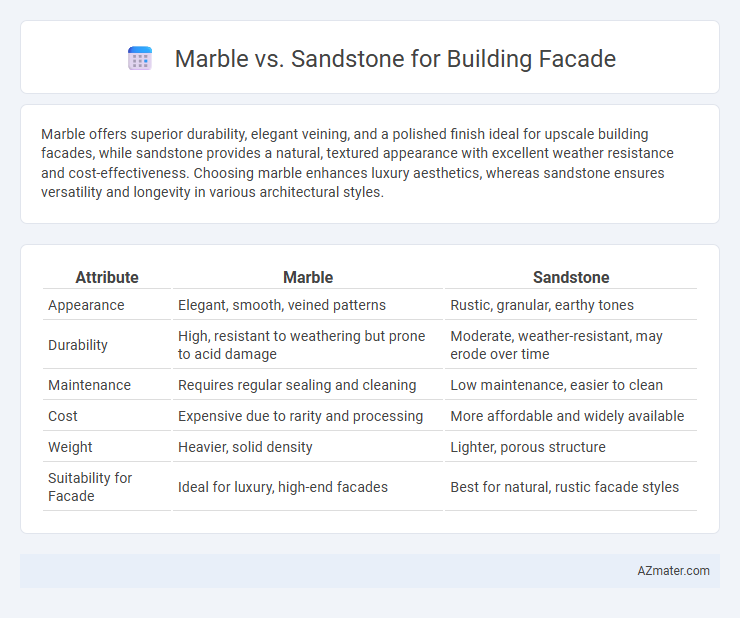Marble offers superior durability, elegant veining, and a polished finish ideal for upscale building facades, while sandstone provides a natural, textured appearance with excellent weather resistance and cost-effectiveness. Choosing marble enhances luxury aesthetics, whereas sandstone ensures versatility and longevity in various architectural styles.
Table of Comparison
| Attribute | Marble | Sandstone |
|---|---|---|
| Appearance | Elegant, smooth, veined patterns | Rustic, granular, earthy tones |
| Durability | High, resistant to weathering but prone to acid damage | Moderate, weather-resistant, may erode over time |
| Maintenance | Requires regular sealing and cleaning | Low maintenance, easier to clean |
| Cost | Expensive due to rarity and processing | More affordable and widely available |
| Weight | Heavier, solid density | Lighter, porous structure |
| Suitability for Facade | Ideal for luxury, high-end facades | Best for natural, rustic facade styles |
Introduction to Marble and Sandstone Facades
Marble facades offer a luxurious and timeless appearance, prized for their smooth texture, high durability, and resistance to weathering, making them ideal for upscale architectural designs. Sandstone facades provide a natural, earthy aesthetic with excellent thermal insulation properties and versatility in color and grain, widely used in both historical and contemporary structures. Both materials require specific maintenance to preserve their structural integrity and appearance over time in building exteriors.
Visual Appeal: Aesthetic Differences
Marble offers a luxurious, polished surface with unique veining patterns that create a sophisticated and elegant facade, while sandstone provides a more rustic, textured appearance with natural earthy tones that blend seamlessly with outdoor environments. The high gloss of marble reflects light beautifully, emphasizing architectural details, whereas sandstone's matte finish imparts a warm, organic charm that evolves with weathering over time. Choosing between marble and sandstone for building facades depends on desired aesthetic impact--marble suits modern, opulent designs; sandstone complements historic or naturalistic styles.
Durability and Longevity Comparison
Marble exhibits higher durability than sandstone due to its denser crystalline structure, making it more resistant to weathering, scratching, and pollution. Sandstone, while more porous and susceptible to erosion and discoloration, offers natural resistance to freeze-thaw cycles and is easier to repair in facade applications. In terms of longevity, marble facades often exceed 50 years with proper maintenance, whereas sandstone typically lasts 30 to 40 years but can degrade faster in harsh climates.
Weather Resistance and Maintenance Needs
Marble offers superior weather resistance due to its dense, non-porous surface that withstands rain, wind, and temperature fluctuations with minimal erosion or discoloration. Sandstone, being more porous, absorbs moisture and is prone to weathering, necessitating frequent sealing and repairs to maintain structural integrity and appearance. Maintenance for marble facades typically involves regular cleaning and occasional sealing, whereas sandstone requires more intensive upkeep to prevent water damage and surface degradation.
Cost Analysis: Marble vs Sandstone
Marble typically costs between $40 and $100 per square foot, making it a premium choice for building facades due to its luxurious appearance and durability. Sandstone is more budget-friendly, ranging from $20 to $60 per square foot, offering a natural aesthetic with moderate durability. While marble requires higher upfront investment and maintenance costs, sandstone provides a cost-effective alternative with easier installation and repair expenses.
Environmental Impact and Sustainability
Marble extraction involves intensive quarrying processes that generate significant energy consumption and carbon emissions, whereas sandstone quarrying typically exerts a lower environmental footprint due to less energy-intensive methods. Marble's susceptibility to acid rain and pollution accelerates weathering, reducing its long-term durability and increasing maintenance frequency, while sandstone's porosity allows better moisture regulation, enhancing facade longevity with fewer replacements. Sustainable building practices favor sandstone for facade applications since it supports local sourcing, requires less energy during production, and offers superior ecological benefits through lower embodied carbon and biodegradability.
Installation Process and Complexity
Marble installation for building facades requires precise handling due to its brittleness and weight, often necessitating specialized anchors and skilled labor to ensure stability and alignment. Sandstone, being softer and more porous, allows for easier cutting and shaping on-site, but demands careful sealing and mortar application to prevent moisture penetration and structural weakening. Both materials involve complex installation steps, but marble involves stricter requirements for support systems and transportation logistics compared to the relatively simpler handling of sandstone.
Customization and Design Flexibility
Marble offers superior customization and design flexibility for building facades due to its smooth texture and wide range of colors and patterns, enabling intricate carving and polishing for unique architectural details. Sandstone provides a more natural, textured appearance with varied hues but is generally less adaptable to fine detailing and complex shapes compared to marble. The choice between marble and sandstone hinges on the desired aesthetic complexity and the level of precision required for facade customization.
Popular Architectural Applications
Marble and sandstone are widely used in building facades, offering distinct aesthetic and functional advantages. Marble is favored for luxury structures and iconic landmarks due to its polished surface and durability, while sandstone is popular in historical and rustic designs for its warm, natural texture and weather resistance. Architects often choose marble for modern high-end projects and sandstone for heritage buildings, enhancing architectural character and environmental integration.
Choosing the Right Stone for Your Project
Marble offers a luxurious, polished finish and superior durability, making it ideal for high-end building facades requiring a sophisticated appearance and resistance to weathering. Sandstone provides a textured, natural look with excellent breathability, suitable for projects emphasizing a rustic or earthy aesthetic while accommodating moderate maintenance. Selecting the right stone depends on environmental exposure, desired architectural style, and long-term upkeep capabilities to ensure optimal performance and visual appeal.

Infographic: Marble vs Sandstone for Building Facade
 azmater.com
azmater.com